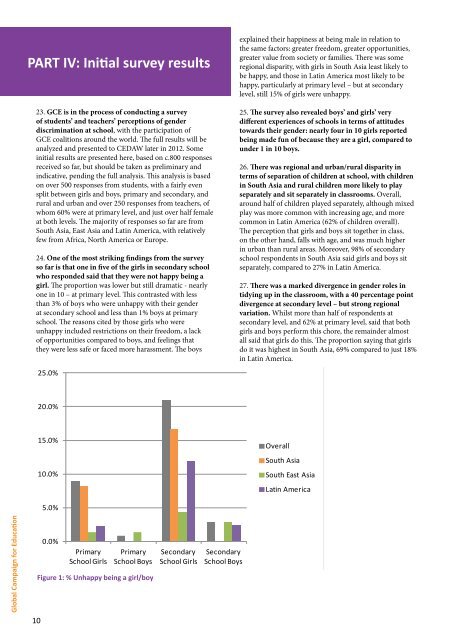Gender Discrimination in Education: The violation of rights of women ...
Gender Discrimination in Education: The violation of rights of women ...
Gender Discrimination in Education: The violation of rights of women ...
You also want an ePaper? Increase the reach of your titles
YUMPU automatically turns print PDFs into web optimized ePapers that Google loves.
PART IV: Initial survey results<br />
23. GCE is <strong>in</strong> the process <strong>of</strong> conduct<strong>in</strong>g a survey<br />
<strong>of</strong> students’ and teachers’ perceptions <strong>of</strong> gender<br />
discrim<strong>in</strong>ation at school, with the participation <strong>of</strong><br />
GCE coalitions around the world. <strong>The</strong> full results will be<br />
analyzed and presented to CEDAW later <strong>in</strong> 2012. Some<br />
<strong>in</strong>itial results are presented here, based on c.800 responses<br />
received so far, but should be taken as prelim<strong>in</strong>ary and<br />
<strong>in</strong>dicative, pend<strong>in</strong>g the full analysis. This analysis is based<br />
on over 500 responses from students, with a fairly even<br />
split between girls and boys, primary and secondary, and<br />
rural and urban and over 250 responses from teachers, <strong>of</strong><br />
whom 60% were at primary level, and just over half female<br />
at both levels. <strong>The</strong> majority <strong>of</strong> responses so far are from<br />
South Asia, East Asia and Lat<strong>in</strong> America, with relatively<br />
few from Africa, North America or Europe.<br />
24. One <strong>of</strong> the most strik<strong>in</strong>g f<strong>in</strong>d<strong>in</strong>gs from the survey<br />
so far is that one <strong>in</strong> five <strong>of</strong> the girls <strong>in</strong> secondary school<br />
who responded said that they were not happy be<strong>in</strong>g a<br />
girl. <strong>The</strong> proportion was lower but still dramatic - nearly<br />
one <strong>in</strong> 10 – at primary level. This contrasted with less<br />
than 3% <strong>of</strong> boys who were unhappy with their gender<br />
at secondary school and less than 1% boys at primary<br />
school. <strong>The</strong> reasons cited by those girls who were<br />
unhappy <strong>in</strong>cluded restrictions on their freedom, a lack<br />
<strong>of</strong> opportunities compared to boys, and feel<strong>in</strong>gs that<br />
they were less safe or faced more harassment. <strong>The</strong> boys<br />
25.0%<br />
expla<strong>in</strong>ed their happ<strong>in</strong>ess at be<strong>in</strong>g male <strong>in</strong> relation to<br />
the same factors: greater freedom, greater opportunities,<br />
greater value from society or families. <strong>The</strong>re was some<br />
regional disparity, with girls <strong>in</strong> South Asia least likely to<br />
be happy, and those <strong>in</strong> Lat<strong>in</strong> America most likely to be<br />
happy, particularly at primary level – but at secondary<br />
level, still 15% <strong>of</strong> girls were unhappy.<br />
25. <strong>The</strong> survey also revealed boys’ and girls’ very<br />
different experiences <strong>of</strong> schools <strong>in</strong> terms <strong>of</strong> attitudes<br />
towards their gender: nearly four <strong>in</strong> 10 girls reported<br />
be<strong>in</strong>g made fun <strong>of</strong> because they are a girl, compared to<br />
under 1 <strong>in</strong> 10 boys.<br />
26. <strong>The</strong>re was regional and urban/rural disparity <strong>in</strong><br />
terms <strong>of</strong> separation <strong>of</strong> children at school, with children<br />
<strong>in</strong> South Asia and rural children more likely to play<br />
separately and sit separately <strong>in</strong> classrooms. Overall,<br />
around half <strong>of</strong> children played separately, although mixed<br />
play was more common with <strong>in</strong>creas<strong>in</strong>g age, and more<br />
common <strong>in</strong> Lat<strong>in</strong> America (62% <strong>of</strong> children overall).<br />
<strong>The</strong> perception that girls and boys sit together <strong>in</strong> class,<br />
on the other hand, falls with age, and was much higher<br />
<strong>in</strong> urban than rural areas. Moreover, 98% <strong>of</strong> secondary<br />
school respondents <strong>in</strong> South Asia said girls and boys sit<br />
separately, compared to 27% <strong>in</strong> Lat<strong>in</strong> America.<br />
27. <strong>The</strong>re was a marked divergence <strong>in</strong> gender roles <strong>in</strong><br />
tidy<strong>in</strong>g up <strong>in</strong> the classroom, with a 40 percentage po<strong>in</strong>t<br />
divergence at secondary level – but strong regional<br />
variation. Whilst more than half <strong>of</strong> respondents at<br />
secondary level, and 62% at primary level, said that both<br />
girls and boys perform this chore, the rema<strong>in</strong>der almost<br />
all said that girls do this. <strong>The</strong> proportion say<strong>in</strong>g that girls<br />
do it was highest <strong>in</strong> South Asia, 69% compared to just 18%<br />
<strong>in</strong> Lat<strong>in</strong> America.<br />
20.0%<br />
15.0%<br />
10.0%<br />
Overall<br />
South Asia<br />
South East Asia<br />
Lat<strong>in</strong> America<br />
5.0%<br />
Global Campaign for <strong>Education</strong><br />
0.0%<br />
Primary<br />
School Girls<br />
Primary<br />
School Boys<br />
Figure 1: % Unhappy be<strong>in</strong>g a girl/boy<br />
Secondary<br />
School Girls<br />
Secondary<br />
School Boys<br />
10
















